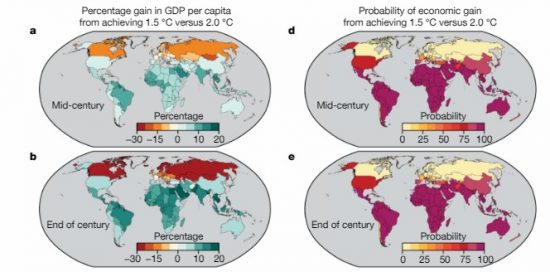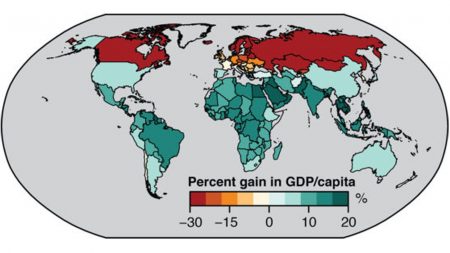May 26, 2018 – A Stanford University study published May 23, 2018, describes the potential reduction in economic damage if the world can halt global warming at 1.5 Celsius (2.4 Fahrenheit). The study reviewed the historical relationship between temperature and Gross Domestic Product (GDP). It concluded that staying within the 1.5 Celsius limit would save the world economy 3% of global GDP.
The study notes that if temperatures can be held to 1.5 Celsius then 71% of the world’s countries representing 90% of the world’s population would have a better than 75% chance of experiencing positive economic benefits including the three largest economies: the United States, China, and Japan. Countries that would gain the most are the poorer ones predominantly located closer to the equator where lowering the warming would lead to a far better outcome in terms of GDP growth. Even small reductions in the global temperature target limit would substantially improve the GDP of these countries. Northern countries, however, would see the least growth in GDP based on the study with higher temperature increases than the mean impacting them negatively.
Using GDP as a measure to calculate climate change impacts based on varying temperature rise is a novel approach to analyzing future trends. The numbers in this study far exceed any in previous forecasts which talk about hundreds of billions of dollars in GDP impacts versus multiples of trillions.
More disturbing is the conclusion drawn by the authors noting that although the Paris Climate Agreement calls for a 1.5 Celsius optimal target, and a 2 Celsius upper limit, when looking at actual Nationally Determined Contributions (NDCs) of the signatories it is far more likely that we will see mean average temperature rise by 2.5 to 3 Celsius (4.5 to 5.4 Fahrenheit) globally by end of century. They further conclude that failing to meet NDC commitments that yield a lower mean average temperature rise will produce substantial reductions in global GDP, in excess of 25%.
There is an additional author caveat. They study notes it cannot account for “historically unprecedented changes” such as large-scale sea level rise from the disappearance of land-based ice in Antarctica and Greenland, and remark that at 2 Celsius or higher the unprecedented would be far more likely to happen than at 1.5 Celsius.
Peer review of the study praised the work but also pointed out its limitations including no way to measure the impact of technological innovation that could alter temperature rise or technologies that could increase energy efficiencies to make adaptation less economically damaging. Nor does the study look at changes in the use of fossil fuels and how that would contribute to improvements in the ecosystem of the overall global community which would increase GDP even more than forecast.
The authors, however, point out that it is in the best interest of all countries to meet the 1.5 Celsius upper limit regardless. It means the quality of life for most of the world’s population will not have to endure significant disruption.

















